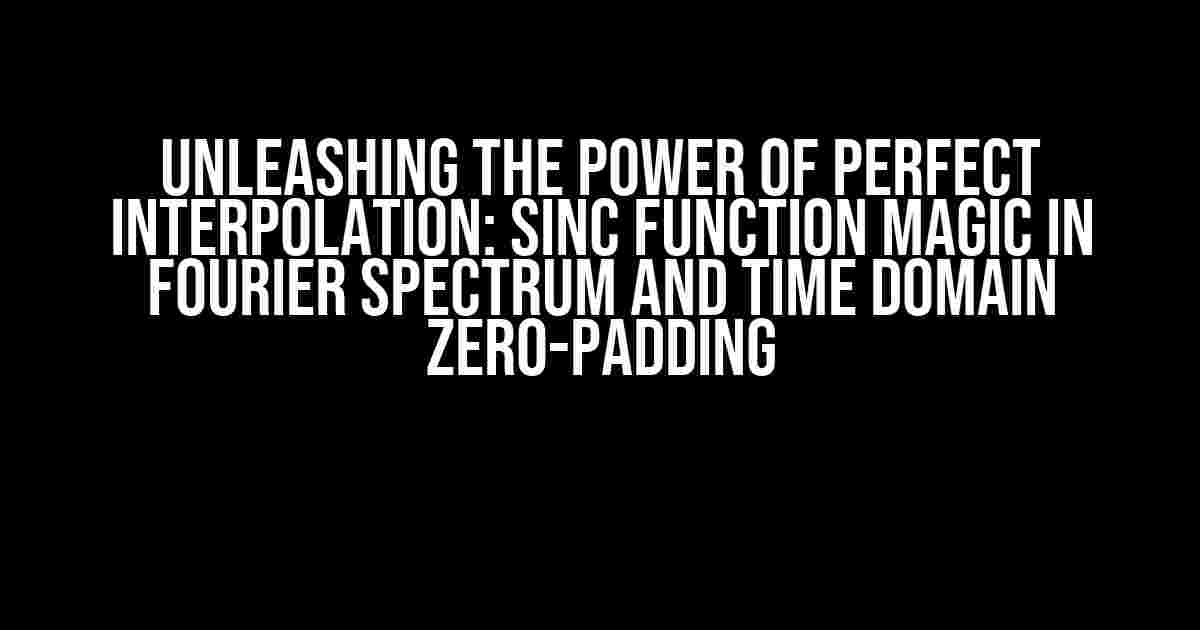Are you tired of dealing with aliasing and spectral leakage in your signal processing endeavors? Do you wish to unlock the secrets of perfect interpolation, effortlessly transitioning between the frequency and time domains? Look no further! In this comprehensive guide, we’ll delve into the fascinating realm of sinc function-based perfect interpolation, exploring its equivalence to zero-padding in the time domain and its applications in Fourier spectrum analysis.
The Sinc Function: A Gentle Introduction
The sinc function, also known as the cardinal sine function, is a mathematical gem that plays a crucial role in signal processing and communications. It’s defined as:
sinc(x) = sin(πx) / πxThis innocuous-looking function possesses some remarkable properties, which we’ll exploit to achieve perfect interpolation in the Fourier domain.
Fourier Transform and the Sinc Function
The Fourier transform, a cornerstone of signal processing, decomposes a signal into its constituent frequencies. When we employ the sinc function as a window function in the Fourier transform, something magical happens:
X(f) = ∫[x(t) \* sinc(t) \* e^{-j2πft}] dtThe resulting Fourier transform, X(f), exhibits a crucial property: it’s band-limited, meaning the signal energy is confined to a specific frequency range. This band-limitation is the key to perfect interpolation.
Perfect Interpolation: A Sinc Function Odyssey
Perfect interpolation, also known as ideal interpolation, is the process of reconstructing a continuous-time signal from its discrete-time samples. The sinc function enables us to achieve this feat by serving as a weighting function in the interpolation process:
x(t) = ∑[x[n] \* sinc((t-nT)/T)]Here, x[n] represents the discrete-time samples, T is the sampling period, and t is the continuous-time variable. The sinc function ensures that the interpolated signal x(t) is band-limited, preserving the original signal’s frequency content.
Equivalence to Zero-Padding in Time Domain
Now, here’s the fascinating part: perfect interpolation using the sinc function is equivalent to zero-padding in the time domain. Yes, you read that right! Zero-padding, a technique commonly used in Fourier transform-based signal processing, can be replaced by sinc function-based interpolation:
x_padded[n] = [x[n], 0, ..., 0] (zero-padding)This equivalence is rooted in the fact that both approaches ensure the signal is band-limited, allowing for perfect reconstruction in the frequency domain.
Applications and Advantages
The sinc function-based perfect interpolation and its equivalence to zero-padding in the time domain have far-reaching implications in various signal processing applications:
- Sampling rate conversion: Perfect interpolation enables seamless conversion between different sampling rates, critical in multimedia processing and communication systems.
- Spectral analysis: The sinc function-based approach ensures accurate frequency domain analysis, free from aliasing and spectral leakage.
- Filter design: Perfect interpolation facilitates the design of ideal filters, such as the sinc filter, which enjoys widespread use in signal processing.
- Image and signal compression: The sinc function’s band-limiting property makes it an attractive tool for efficient compression algorithms.
Challenges and Limitations
While the sinc function-based perfect interpolation offers numerous advantages, it’s not without its challenges and limitations:
- Computational complexity: The sinc function’s infinite duration and oscillatory nature can lead to computationally intensive calculations.
- Truncation errors: Truncating the sinc function can introduce errors, compromising the interpolation’s perfectness.
- Numerical instability: The sinc function’s sensitive nature can lead to numerical instability in certain implementations.
Conclusion
In conclusion, the sinc function-based perfect interpolation is a powerful tool for signal processing and analysis, offering a seamless transition between the frequency and time domains. By harnessing the equivalence to zero-padding in the time domain, we can unlock the secrets of Fourier spectrum analysis and unleash the full potential of signal processing applications. While challenges and limitations exist, the benefits of perfect interpolation make it an indispensable technique in the realm of signal processing.
| Keyword | Definition |
|---|---|
| Perfect Interpolation | The process of reconstructing a continuous-time signal from its discrete-time samples, ensuring band-limitation and preservation of original frequency content. |
| Sinc Function | A mathematical function defined as sin(πx) / πx, playing a crucial role in signal processing and communications. |
| Zero-Padding | A technique used in Fourier transform-based signal processing, where the signal is padded with zeros to increase its length, ensuring band-limitation. |
| Fourier Spectrum | The representation of a signal in the frequency domain, obtained through the Fourier transform. |
By embracing the sinc function’s magic, you’ll be well-equipped to tackle a wide range of signal processing challenges, unlocking the full potential of perfect interpolation and its applications. Happy signal processing!
Frequently Asked Question
Get ready to dive into the world of signal processing and understand the magic of perfect interpolation!
What is perfect interpolation in signal processing?
Perfect interpolation, also known as sinc interpolation, is a mathematical technique used to reconstruct a continuous-time signal from its discrete-time samples. It’s like filling in the blanks to get the complete picture!
How is perfect interpolation related to the Fourier spectrum?
The magic happens because the perfect interpolation of a signal in the time domain is equivalent to padding the Fourier spectrum of the signal with zeros! This means that the interpolation process doesn’t add any new information, but rather refines the existing one.
Why is zero-padding in the Fourier spectrum equivalent to perfect interpolation?
This equivalence is due to the duality property of the Fourier transform. When you pad the Fourier spectrum with zeros, you’re effectively interpolating the signal in the time domain. Conversely, perfect interpolation in the time domain is equivalent to padding the Fourier spectrum with zeros!
What are the practical applications of perfect interpolation?
Perfect interpolation has many real-world applications, such as image and audio processing, data resampling, and signal reconstruction. It’s used in many industries, including healthcare, finance, and entertainment, to improve the quality and fidelity of signals!
Is perfect interpolation a lossless process?
Yes, perfect interpolation is a lossless process because it doesn’t add any new information or noise to the original signal. It simply refines the existing information to provide a more detailed representation of the signal!
